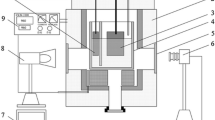Abstract
The nature of the aerosol emitted from a scale model zinc electrowinning system, operated under industrial conditions, has been established as a function of bubble formation rate, electrode surface characteristics, coalescence of bubbles, and control strategies. The emitted aerosol was collected and characterized using an Andersen Ambient Impactor. The effect of the relative humidity of the ambient air on the composition and density of the aerosol droplets was determined, permitting comparison of emissions on a standard basis. The size distribution of the aerosol was found to be of a bimodal nature indicating the presence of both film and jet droplets of geometric mean size 2 and 30μm respectively. The amount and distribution of the aerosol were found to depend on the bubble size distribution in the cell which in turn depends on the anode surface, the amount and nature of the MnO2 scale and surface active substances in the electrolyte. The gross emission rate was about 2–3 mgm−2 s−1 without any control. A new method of control of the acidic emissions is proposed based on observations made and results obtained from the study of the aerosol characteristics. Providing means of enhancing bubble coalescence below the electrolyte surface results in fewer and larger bubbles which yield less aerosol. The method has been evaluated in both zinc and copper electrowinning and leads to reduction of aerosol emission by over 90%.
Similar content being viewed by others
References
R. L. Cavender, J. L. Williams, W. H. Steinhagen and D. Woods,J. Toxicol. Environ. Health,2 (1977) 1147.
T. B. Marionen and M. Patel,J. Amer. Ind. Hyg. Assoc. 42(6) (1981) 453.
F. MacIntyre,J. Geophys. Res. 77(27) (1972) 5211.
Y. Toba,J. Oceanogr. Soc. Jpn. 15(3) (1959) 1.
M. P. Paterson and K. T. Spillane,Quart J. R. Met. Soc. 95 (1969) 526.
F. H. Garner, S. R. M. Ellis and J. A. Lacey,Trans. Instn. Chem. Eng. 32 (1954) 222.
D. C. Blanchard, ‘The Electrification of the Atmosphere by Particles from Bubbles in the Sea’, in ‘Progress in Oceanography’, Vol. 1, MacMillan, New York, (1963) p. 71.
N. Mitsuishi, S. Sakata, Y. Matsuda, Y. Yamamoto and Y. Oyama, ‘Studies on Liquid Entrainment’, AEC-tr-4225,1961 (Translation of three Japanese papers).
V. G. Gleim,J. Appl. Chem. USSR 28(1) (1955) 9.
V. G. Gleim,ibid. 26(11) (1953) 1099.
E. M. Lavrova,ibid. 46(8) (1973) 1848.
C. W. Miller, W. V. Kessler and V. L. Anderson,Environ. Lett. 10(1) (1975) 1.
C. J. Wilson, MSc Thesis, University of Manchester (1970).
A. Vogel, ‘Vogel's Textbook of Quantitative Inorganic Analysis’, 4th ed., Longman, New York (1978) p. 330.
Niosh, ‘Manual of Analytical Methods’, Vol. 3, 2nd ed., US Department of Health, Education, and Welfare, Cincinnati (1977).
H. N. S. Schafer,Anal. Chem. 39(14) (1967) 1719.
‘CRC Handbook of Chemistry and Physics’, 59th ed., (edited by R. C. Weast and M. J. Astle) CRC Press (1978).
Author information
Authors and Affiliations
Rights and permissions
About this article
Cite this article
Papachristodoulou, A., Foulkes, F.R. & Smith, J.W. Bubble characteristics and aerosol formation in electrowinning cells. J Appl Electrochem 15, 581–590 (1985). https://doi.org/10.1007/BF01059300
Received:
Issue Date:
DOI: https://doi.org/10.1007/BF01059300




